Introduction
Millions of the world’s poorest people depend on the ecosystem goods and services provided by coral reefs. Coral reefs are particularly important for fishing and tourism, but also contribute to coastal protection and in some places have significant cultural values. Coral reefs are one of the most productive and biologically diverse aquatic environments on Earth, yet they are also one of the most ecologically sensitive to climatic change, are currently undergoing large-scale changes. Consequently, evaluating the links between the social and ecological and dimensions of vulnerability to climate change is a priority for reducing difficultto- reverse impacts on coral reefs and increasing human food security.
Climate change is affecting coral reefs through alterations in the long-term mean environmental conditions, inter-annual cycles, and seasonality, and the frequency of extreme climate events. The increasing frequency of extreme climatic events can affect fish habitat, productivity, and distribution, as well as impact directly on fishing operations and the physical infrastructure of coastal communities. Extreme events such as high-intensity cyclones and increased sea surface temperatures can have profound impacts on coral reef ecosystems and the communities that depend on them. For example, elevated sea temperature events can cause corals to bleach and die. This can alter the goods and services that coral reefs provide by changing the species compositions of fish and potentially reducing reef fisheries productivity, and consequently harming reef-dependent people. The current era of rapid anthropogenic-driven climate change has the potential to undermine coral-reef associated livelihoods.
An increasingly critical aspect of sustaining coral reefs and the livelihoods of dependent people is understanding the vulnerability of particular reefs and their associated human communities to climate change impacts. Vulnerability, in the context of social and environmental change, is defined as the state of susceptibility to harm from perturbations. Understanding vulnerability in coral reef fisheries is complicated because there is considerable heterogeneity in: 1) places that experience climate change-related events such as coral bleaching; 2) the ways that coral reef ecosystems are affected by and can recover from these impacts; 3) the ways that societies and individuals are impacted by these changes; and 4) the capacity of people to cope with and adapt to these changes. Knowledge about how vulnerable a system is, and the specific conditions that make it vulnerable, can help to provide a foundation for developing key actions that minimize the impacts of environmental change on people.
The conceptual framework of vulnerability to climate change provides a basis for operationalizing and assessing the vulnerability of linked social and ecological systems. A framework promoted by the Intergovernmental Panel on Climate Change (IPCC) has been widely adopted for vulnerability assessments (Figure S7 in File S1). The framework suggests that the extent to which people’s livelihoods are vulnerable to the impacts of climate change is dependent on: 1) their exposure to climate impacts (i.e. if impacts are felt in their location); 2) their sensitivity (i.e. the extent to which their livelihood is affected by an impact); and 3) their capacity to adapt to the likely impacts.
Exposure is the degree to which a system is stressed by climate, such as the magnitude, frequency, and duration of a climatic event such as temperature anomalies or extreme weather events. In a practical sense, exposure is the extent to which a region, resource, or community experiences change. For fishing communities, exposure captures how much the resource they depend on will be affected by environmental change. In tropical reef fisheries, exposure can vary depending on factors such as oceanographic conditions, prevailing winds, and latitude, which can increase the likelihood of being impacted by events such as cyclones or coral bleaching. Sensitivity, in the context of environmental change, is the susceptibility of a defined component of the system to harm, resulting from exposure to stresses. The sensitivity of social systems depends on economic, political, cultural and institutional factors that allow buffering or attenuation of change. For example, social systems are more likely to be sensitive to climate change if they are highly dependent on a climate-vulnerable natural resource. Sensitivity can confound (or ameliorate) the social and economic effects of climate exposure. Adaptive capacity is a latent characteristic that reflects peoples’ ability to anticipate and respond to changes, and to minimize, cope with, and recover from the consequences of change. For example, people with low adaptive capacity may have difficulty adapting to change or taking advantage of the opportunities created by changes in the availability of ecosystem goods and services stimulated by climate change or changes in management.
The above examples illustrate the three dimensions of social vulnerability, but they also have ecological components. For example, the sensitivity of ecological systems to climate change can include physiological tolerances to change and/or variability in physical and chemical conditions (i.e. temperature, pH, etc.), such as certain corals that are highly sensitive to increases in sea temperatures. This creates the need to evaluate both systems and, therefore, a new multi-disciplinary literature on the vulnerability of linked social-ecological systems to climate change has emerged. The central idea behind linked or coupled socialecological systems is that human actions and social structures profoundly influence ecological dynamics, and vice-versa.
Modified Vulnerability Framework
Here, we use a case study from the Kenyan coral reef fishery to operationalize a modification of the IPCC vulnerability framework. Our aim is to improve on previously developed applications of vulnerability in fisheries by explicitly considering both social and ecological dimensions of vulnerability. Our specific modification to the IPCC framework entails linking two vulnerability sub-models: one represents the components of ecological vulnerability to exposure to climate change, while the other represents social vulnerability to changes in the ecological system (Figure 1). In our modified framework, the potential impact of climate change on ecological systems results from the physical exposure to climatic stressors combined with the sensitivity of those ecosystems. Whether these potential impacts are fully experienced in the long term depends on the potential of the ecosystem to recover its basic structure and function in response to impacts. Thus, the combination of ecological exposure, ecological sensitivity, and ecological recovery potential (together what we refer to as ecological vulnerability) result in the degree to which climate change will impact on the continued supply of ecosystem goods and services. In turn, this ecological vulnerability represents the exposure of the socioeconomic domain to climate threats. The overall social-ecological vulnerability is then a result of the sensitivity of socioeconomic systems to ecological vulnerability, and the adaptive capacity of the society to adapt to such impacts (Figure 1).
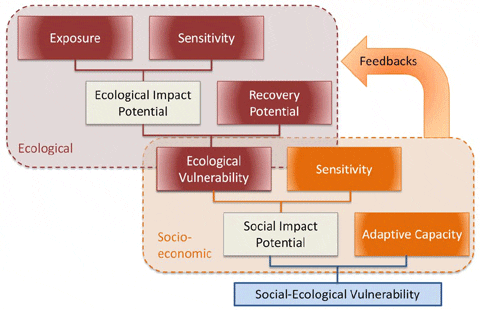
The Social and Ecological Context of the Kenyan Case Study
Our Kenyan case study demonstrates how assessments of exposure, sensitivity, and adaptive capacity can be undertaken for both social and ecological subsystems and provide an overall assessment of system vulnerability. Kenya presents an interesting case study to evaluate social-ecological vulnerability for four key reasons. First, in a comparison of vulnerability across five Western Indian Ocean countries, Kenyan sites are the most vulnerable overall, but there is considerable spread in both sensitivity and adaptive capacity. Indeed, much of the variability encountered in the region is contained within Kenya. Second, Kenya is at the frontline of climate change- its reefs were severely impacted by the 1998 El Nino-related coral-bleaching event. Temperature records suggest that the scale of this temperature anomaly was unprecedented and resulted in high levels of coral mortality in the northern Indian Ocean. Consequently, extreme climate events are a current reality rather than a distant possibility. Third, people in coastal Kenya are heavily dependent on fisheries and other natural resources for their livelihoods. Fishing in Kenya is typically conducted from the beach to the fringing reef within the sand, coral, and seagrass habitats of the fringing reef lagoon. Last, Kenya has a range of marine resource governance regimes, ranging from large national marine parks enforced by paramilitary organizations to largely open access areas where regular use of destructive beach seine nets damage marine habitats. In between are community controlled co-managed areas called Beach Management Units (BMUs). In recent years, BMUs have started developing community-based fishery closures. Together this governance spectrum presents an opportunity to examine whether, and how different, governance regimes have the potential to influence vulnerability.
Results
Ecological Aspects of Vulnerability
The ecological indicators were highly variable across the 15 study sites (Table S6 in File S1). Sites included degraded reefs with low coral abundance (<1 per cent absolute live coral cover, Takaungu), limited coral diversity (13 genera, Kuruwitu), low reef fish biomass (<100 kg/ha, Kanamai, Takaungu, RasIwatine), limited herbivore grazing diversity (<0.01 Simpson index of Acanthurids, Siganids, and Scarids, Kanamai, RasIwatine), and herbivore grazing rates that were substantially less than estimated rates of algal production (>100 kg/day deficit, Mayungu, Takaungu). More intact reefs had higher coral cover (>50 per cent, Mradi), more diverse coral assemblages (25 genera, Changai, Kisite), and more productive fish communities (~1600 kg/ha reef fish biomass, Kisite) with greater herbivore diversity (~0.7 Simpson index, Mombasa) and higher herbivore grazing relative to algal production (>50 kg/day surplus, Changai, Kisite).
The wide range of ecological condition across the 15 coral reef sites in Kenya led to considerable spread in the composite ecological vulnerability index (Table S6 in File S1, Figure 3). Ecological vulnerability ranged from 0.42 to 0.79 (mean 0.64±0.11 SD, vulnerability index scaled between 0 and 1). The three facets of ecological vulnerability (ecological exposure, ecological sensitivity and ecological recovery potential; Table S7 in File S1) were not strongly correlated, suggesting these different components of ecological resilience are not related (Pearson correlation coefficients: ecological exposure to ecological sensitivity, r =-0.46, ecological exposure to ecological recovery potential, r=-0.15, ecological sensitivity to ecological recovery potential, r = 0.11). Overall, fished sites had marginally higher ecological vulnerability than sites within tengefus and no-take marine reserves (one-way Analysis of Variance, F = 3.2, df =2,12, P = 0.08; Table S7 in File S1; Figure 3).
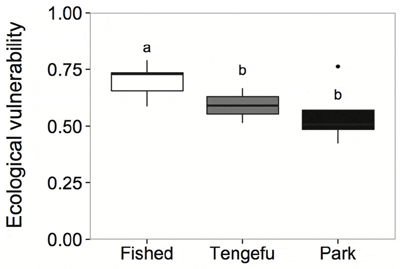
The two principal components axes explained 61.7 per cent of the variation among indicators across the sites (Figure 4). Management did not distinguish exposure because some fished reefs, community-managed tengefus, and government no-take marine reserves were associated with high levels of exposure (upper-right quadrant of Figure 4). Fished reefs were associated with higher climate sensitivities of coral and fish assemblages (bottom quadrants). Recovery potential indicators separated into two groups. Herbivore diversity, rugosity, fish biomass, and coral size were associated with the no-take marine reserves (upper-left quadrant of Figure 4), while coral richness, hard coral cover, and higher rates of herbivore grazing relative to algal production were associated with one tengefu, Mradi, and some fished reefs (lowerleft quadrant).
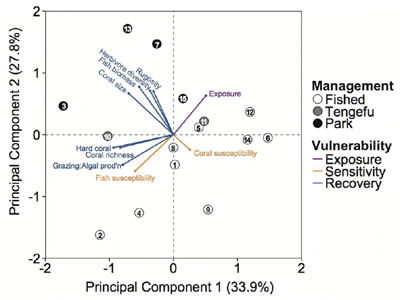
There was a wide spread of the three facets of ecological vulnerability across different types of fisheries management. Variable exposure, high sensitivity, and low recovery potential to coral bleaching events resulted in higher ecological vulnerability scores for some fished sites, one tengefu (Kuruwitu) and some notake marine reserves (upper right of Figure 5). Other no-take reserves and one tengefu (Mradi) were associated with lower ecological vulnerability due to low ecological sensitivity and high ecological recovery potential, despite medium to high exposure (Table S6 and S7 in File S1; Figure 5).

Social Aspects of Vulnerability
Social sensitivity. We focused our sampling on direct resource users, meaning that the resource dependence aspects of sensitivity had relatively little variation between communities (ranging from 0.23–.35; Table S1 in File S1). Our analysis of the gear use side of sensitivity produced some counter-intuitive results and highlighted some key research gaps (Table S2 and S3 in File S1). In particular, we found that the sensitivity of certain gears types to the impacts of coral bleaching events varied considerably (Fig. S5 in File S1). In particular, the species targeted by traps and beach seine nets in the Kenyan fishery were expected to decline as a result of bleaching-induced mortality. However, available information to date suggested that the species targeted by other gears may actually demonstrate short-term increases in abundance as a result of bleaching mortality (Fig. S5 in File S1). However, we only had species-specific responses for 48–69 per cent of the catch abundance (Fig. S3–S4, Table S4 in File S1) and many of the species-specific responses were supported by only one study (Fig. S6 in File S1).
Social adaptive capacity. The ten communities displayed considerable variation in many of the indicators of adaptive capacity that we measured (Table S8 in File S1), particularly access to credit, debt, human agency, capacity to change, social capital, community infrastructure, and material style of life. For example, the proportion of respondents not in debt (recorded as more than one week’s typical earnings) ranged from 55–90 per cent. Alternatively, several of the indicators displayed little variation between the highest and lowest values, particularly, occupational mobility, gear diversity, and trust.
We ran a PCA based on the co-variance matrix (because the units were all on the same scale) (Figure 6). Visual inspection of scree plots revealed that the first three Principal Components (PCs), which explained 82 per cent of the variance (Table S9 in File S1), could be used. Social capital, capacity to change, access to credit, community infrastructure, gear diversity, and Material Style of Life (MSL) all had substantial factor loadings on PC 1 (Table S10 in File S1). MSL, occupational multiplicity, and community infrastructure dominated PC2, but gear diversity and access to credit also had substantial loadings on that PC. Interestingly, MSL and community infrastructure loaded negatively on PC2, while gear diversity and occupational multiplicity loaded positively. Human agency loaded highly on the PC3 (Table S10 in File S1). Trust did not load highly on any of the components, primarily because there was little variation in trust between communities. Although there was substantial variation in trust at the individual level, community-level means and standard errors were relatively similar (Table S8 in File S1).
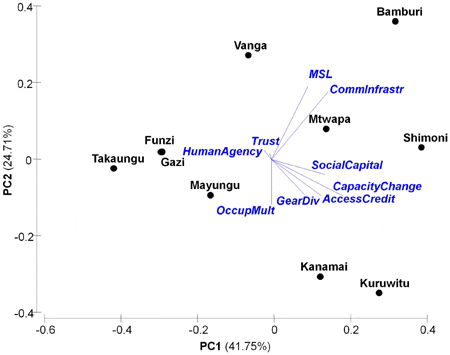
Social-Ecological Vulnerability
Our measure of social-ecological vulnerability comprised three components: 1) social exposure (which is ecological vulnerability; Fig. 1); 2) social sensitivity; and 3) social adaptive capacity. We used a bubble plot to visualize social-ecological vulnerability at our study sites (Figure 7). This visualization helped show how the vulnerability of our communities compared to each other and helped demonstrate which component(s) of vulnerability contributed the most to their vulnerability, so that specific actions could be taken for each of them. For example, Takaungu had a high vulnerability mainly due to its high exposure and low adaptive capacity, even though its sensitivity was low. Actions to improve the vulnerability of this community might focus on increasing adaptive capacity (it is harder to have actions that can reduce exposure). Vanga had a high vulnerability primarily because of its high sensitivity. Actions to improve the vulnerability of this community might focus on decreasing sensitivity.
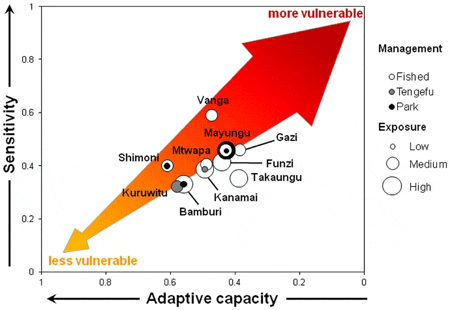
Discussion
Our modification to the IPCC vulnerability assessment framework provides a conceptual model for considering both socioeconomic and ecological dimensions in an integrated assessment of system vulnerability. Integration between socioeconomic and ecological systems highlights and exposes the codependency between the systems components; where vulnerability is visibly and quantitatively influenced by each component. Facing the growing threat of climate change and because of the inter-dependencies between people and ecosystems, understanding the linkages is increasingly important for effective management. Nevertheless, there are few examples quantifying this integrated understanding of vulnerability in the literature.
Integrated vulnerability analyses can be used to identify status, trends, and possible opportunities for adaptation in the face of climate change. In particular, our study exposes the role of local level management in influencing the sensitivity and recovery potential of corals and associated fish assemblages, which ultimately reduces exposure in the social domain. This is in contrast to ecological exposure, which can only be reduced by international action to reduce carbon emissions. Likewise, social adaptive capacity and social sensitivity are also amenable to policy actions at local and national scales.
This case study uses a diagnostic approach and supports the argument that one-size-fits-all or panaceas to adaptation planning are unlikely to succeed. Our methods and results highlight how specific aspects of adaptive capacity and sensitivity can determine the strengths and weaknesses that contribute to high or low vulnerability. This should be useful for adaptation planning that takes advantage of existing capacities and can strengthen the identified weaknesses. By examining the types of vulnerability (exposure, sensitivity and adaptive capacity) that different communities have (e.g. Figure 7), the most appropriate policy priorities become apparent (Table 3). For example, social systems might be buffered from ecological degradation through local management strategies that increase ecological recovery potential (e.g. through marine protected areas or gear-based management). Likewise, social sensitivity could be decreased by promoting the use of gears less likely to be negatively impacted by coral bleaching (e.g. handlines), or by creating supplemental livelihood activities. Adaptive capacity is perhaps the component of vulnerability most amenable to influence, and may be a useful focus for adaptation planning. Some aspects of adaptive capacity, such as infrastructure development, can be directly and predictably enhanced by physical development projects, while other livelihood or cognitive dimensions are not so amenable to enhancement by central government. Alternatively, some aspects of building adaptive capacity, such as skills development, support for micro-credit schemes, and poverty alleviation may be best delivered by NGOs and development organizations working in conjunction with local and national governments.
An important finding of our research highlights that there may be tradeoffs inherent in specific aspects of adaptive capacity, particularly those associated with people’s flexibility and assets. This finding is supported by studies of livelihood diversification, which have found occupational specialization with increasing socioeconomic development. Specialization within industries such as the fishing industry occurs as the result of capital being secured in vessels and equipment. This increases the efficiency of the operation, decreases the price of the product, and maintains social status. Yet, resource-users that target only a few species, or are reliant on a single resource are severely restrained in their ability to be flexible and adapt to changes in the resource relationship. Specialist behaviour is typical of regions in which resources are abundant and predictable and the system is regarded as ‘stable’. However, the ‘stable’ system is not necessarily resilient in the face of change. Thus, in areas where resources are less predictable, a ‘generalist’ or risk-spreading strategy may be more resilient. Generalists or resource-users that target more than one species can exhibit a more flexible nature since they can interchange between resource types as the need arise.
A surprising result from this study is that, based on available information to date, it appears as though temperature-induced coral mortality has the potential to result in modest short-term increases in catches for some gear users. For example, the algae that often grow over dead corals could promote the abundance of certain types of low-trophic herbivorous fishes that are targeted by certain gears. Thus, sensitivity is not always negative; climate change could impact some fish species, some gear, and some people positively. However, a degraded and algal covered reef is unlikely to sustain fish populations after the structural complexity of the reef has declined. Likewise, targeting the species that eat algae may hinder prospects of reef recovery after a bleaching event. Thus, we do not view these potential selective short-term increases in catch as a sustainable fisheries benefit from climate change. Additionally, our initial investigation of the impacts of temperature-induced mortality on reef fishers examined likely changes to in situ abundance of commonly targeted reef fishes, but does not consider status or trends of key fisheries parameters such as catch per unit effort, biomass, trophic structure, or catchability that are often used to estimate yields. Future studies may incorporate these types of fisheries parameters in estimates of gear sensitivity. Lastly, our results here should not be generalized to how other reef fisheries may respond to further bleaching events. Our analysis could produce extremely different results somewhere like Papua New Guinea, where many of the species captured by artisanal fishers are more reef associated and the starting condition of the fishery is much better. A limitation of the approach we employed is that we were unable to examine changes in catch sensitivity over time. A key concept in fisheries is that catch compositions can change over time.
Our study is the most comprehensive of its kind, particularly for reef fisheries. However, there are several caveats about our approach and methodology that are important to acknowledge. We are aware that our index of vulnerability is limited to the effect of a single climate change impact (coral bleaching), through a single impact pathway (impact on fisheries). In reality, climate change is a multifaceted threat that will comprise multiple interacting impacts that will also be mediated or extenuated by other social and economic trends. The impacts of climate change on fisheries through coral bleaching are hard to discern and may be overwhelmed by: i) existing trends such as overexploitation; ii) climate impacts affecting other aspects of the ecosystem (e.g. seagrasses); iii) or socioeconomic characteristics, such as demographics, migration and the provision of food and employment from agriculture. In addition, the novel indexes we use here incorporate multiple sources of uncertainty about the nature of exposure, sensitivity and adaptive capacity and this high level of uncertainty needs to be recognized by adaptation prioritization and planning efforts.
Our methodology also assumes future sensitivity and adaptive capacity based on a snapshot of current conditions. Clearly, climate impacts or other external forces such as development projects (e.g. the proposed port development project in Lamu in northern Kenya) could result in substantial economic and social restructuring of surrounding coastal communities in ways that would profoundly alter social sensitivity and social adaptive capacity. Likewise, this study focuses on impacts on currently targeted species, which could be altered by climate change. For example, climate anomalies in Peru that severely impacted the dominant anchovy fishery also created opportunities for exploitation of different species in different areas, which were taken up fishers who had spatial and technological flexibility to exploit them. Additionally, our ecological research is focused on coral reef fish species, although certain non-coral associated (e.g. Leptoscarus vaigiensis and Siganus sutor), pelagic and semi-pelagic (e.g., Sphyraena barracuda), and non-fish resources (e.g. lobsters and octopus) are also significant fishery resources supporting livelihoods and food security. Despite these caveats, we present a first step to understanding vulnerability, and highlight the importance of maximizing use of all available data when assessing the vulnerability of a place.
This study advances the application of climate change impact and adaptation theory to empirical data, and identifies several key gaps requiring further research. For example, our socioeconomic study focused on direct resource users with only limited information about the broader socioeconomic context, which can be a significant driver of social adaptive capacity. An understanding of the broader socioeconomic context within which resource users are embedded may further progress our understanding of how resource dependent people can be assisted so as to minimise their vulnerability to future climate changes. Similarly, the relative importance of different components of adaptive capacity for adapting to different types and magnitudes of impacts over time is not well understood. For example how can we understand the tradeoff between infrastructure and wealth resources with development and the loss of occupational flexibility? We also recognize that future research will need to consider the susceptibility of fish to climate impacts other than coral bleaching (e.g. ocean acidification), and there is a need to ascertain the species-specific responses to bleaching of five key fishes that makes up a large proportion of the catch (Methods S1 in File S1).
Conclusions
The modified IPCC vulnerability assessment framework provides a useful model for assessing adaptive capacity and sensitivity of social systems that are exposed to changes in the condition of the ecological system upon which they depend. In applying this modified model to resource-dependent communities in Kenya, we are able to derive useful insights into the relative magnitude and key sources of vulnerability to potential climate changes and to consider possible strategies that can minimise vulnerability. The framework allows us to simplify assessments and consider heterogeneity within: 1) places that experience climate changerelated events such as coral bleaching; 2) the ways that coral reef ecosystems are affected by and can recover from these impacts; 3) the ways that societies and individuals are impacted by these changes; and 4) the capacity of people to cope with and adapt to these changes. Overall, indicators of ecological exposure, ecological sensitivity, and ecological recovery potential are different facets of ecological vulnerability, which provides justification to our effort to identify indicators describing these different aspects of the vulnerability. Although focusing on small-scale fisheries that operate in coral reef systems, the vulnerability assessment, framework, and survey we develop are adaptable to other kinds of fishery or natural resource dependent systems. Likewise, the framework could be adapted to explore vulnerability to other kinds of environmental, economic, or social stresses and could be complemented by qualitative social science research methodologies.
December 2013


